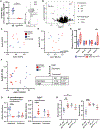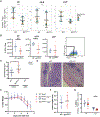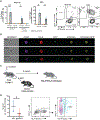Epithelial-myeloid exchange of MHC class II constrains immunity and microbiota composition
- PMID: 34731608
- PMCID: PMC9012449
- DOI: 10.1016/j.celrep.2021.109916
Epithelial-myeloid exchange of MHC class II constrains immunity and microbiota composition
Abstract
Intestinal epithelial cells (IECs) have long been understood to express high levels of major histocompatibility complex class II (MHC class II) molecules but are not considered canonical antigen-presenting cells, and the impact of IEC-MHC class II signaling on gut homeostasis remains enigmatic. As IECs serve as the primary barrier between underlying host immune cells, we reasoned that IEC-intrinsic antigen presentation may play a role in responses toward the microbiota. Mice with an IEC-intrinsic deletion of MHC class II (IECΔMHC class II) are healthy but have fewer microbial-bound IgA, regulatory T cells (Tregs), and immune repertoire selection. This was associated with increased interindividual microbiota variation and altered proportions of two taxa in the ileum where MHC class II on IECs is highest. Intestinal mononuclear phagocytes (MNPs) have similar MHC class II transcription but less surface MHC class II and are capable of acquiring MHC class II from IECs. Thus, epithelial-myeloid interactions mediate development of adaptive responses to microbial antigens within the gastrointestinal tract.
Keywords: H2-Ab1; MHC class II; antigen processing; dendritic cell; immunity; intestinal epithelia; macrophage; microbiome.
Copyright © 2021 The Authors. Published by Elsevier Inc. All rights reserved.
Conflict of interest statement
Declaration of interests The authors declare no competing interests.
Figures







Similar articles
-
MHC Class II Antigen Presentation by the Intestinal Epithelium Initiates Graft-versus-Host Disease and Is Influenced by the Microbiota.Immunity. 2019 Nov 19;51(5):885-898.e7. doi: 10.1016/j.immuni.2019.08.011. Epub 2019 Sep 18. Immunity. 2019. PMID: 31542340 Free PMC article.
-
MHC class II antigen presentation by intestinal epithelial cells fine-tunes bacteria-reactive CD4 T-cell responses.Mucosal Immunol. 2024 Jun;17(3):416-430. doi: 10.1016/j.mucimm.2023.05.001. Epub 2023 May 19. Mucosal Immunol. 2024. PMID: 37209960
-
Intestinal Epithelial Expression of MHCII Determines Severity of Chemical, T-Cell-Induced, and Infectious Colitis in Mice.Gastroenterology. 2020 Oct;159(4):1342-1356.e6. doi: 10.1053/j.gastro.2020.06.049. Epub 2020 Jun 23. Gastroenterology. 2020. PMID: 32589883 Free PMC article.
-
Why do intestinal epithelial cells express MHC class II?Immunology. 2021 Apr;162(4):357-367. doi: 10.1111/imm.13270. Epub 2020 Oct 12. Immunology. 2021. PMID: 32966619 Free PMC article. Review.
-
Epithelial MHC Class II Expression and Its Role in Antigen Presentation in the Gastrointestinal and Respiratory Tracts.Front Immunol. 2018 Sep 25;9:2144. doi: 10.3389/fimmu.2018.02144. eCollection 2018. Front Immunol. 2018. PMID: 30319613 Free PMC article. Review.
Cited by
-
Interactions between the gut microbiota-derived functional factors and intestinal epithelial cells - implication in the microbiota-host mutualism.Front Immunol. 2022 Sep 8;13:1006081. doi: 10.3389/fimmu.2022.1006081. eCollection 2022. Front Immunol. 2022. PMID: 36159834 Free PMC article. Review.
-
Context-Dependent Regulation of Type17 Immunity by Microbiota at the Intestinal Barrier.Immune Netw. 2022 Sep 26;22(6):e46. doi: 10.4110/in.2022.22.e46. eCollection 2022 Dec. Immune Netw. 2022. PMID: 36627936 Free PMC article. Review.
-
Clec12a controls colitis by tempering inflammation and restricting expansion of specific commensals.Cell Host Microbe. 2025 Jan 8;33(1):89-103.e7. doi: 10.1016/j.chom.2024.12.009. Cell Host Microbe. 2025. PMID: 39788099
-
Intestinal epithelial cell-derived components regulate transcriptome of Lactobacillus rhamnosus GG.Front Microbiol. 2023 Jan 4;13:1051310. doi: 10.3389/fmicb.2022.1051310. eCollection 2022. Front Microbiol. 2023. PMID: 36687654 Free PMC article.
-
Small Intestinal Microbiota Oscillations, Host Effects and Regulation-A Zoom into Three Key Effector Molecules.Biology (Basel). 2023 Jan 16;12(1):142. doi: 10.3390/biology12010142. Biology (Basel). 2023. PMID: 36671834 Free PMC article. Review.
References
-
- Anderson MJ (2001). A new method for non-parametric multivariate analysis of variance. Austral Ecol. Published online June 28, 2008. 10.1111/j.1442-9993.2001.01070.pp.x. - DOI
-
- Atarashi K, Tanoue T, Oshima K, Suda W, Nagano Y, Nishikawa H, Fukuda S, Saito T, Narushima S, Hase K, et al. (2013). Treg induction by a rationally selected mixture of Clostridia strains from the human microbiota. Nature 500, 232–236. - PubMed
Publication types
MeSH terms
Substances
Grants and funding
- T32 AI138945/AI/NIAID NIH HHS/United States
- S10 RR026802/RR/NCRR NIH HHS/United States
- R01 AI123106/AI/NIAID NIH HHS/United States
- S10 OD026959/OD/NIH HHS/United States
- R21 AI142409/AI/NIAID NIH HHS/United States
- R01 DK124336/DK/NIDDK NIH HHS/United States
- K22 AI123481/AI/NIAID NIH HHS/United States
- R01 AT011423/AT/NCCIH NIH HHS/United States
- P30 CA042014/CA/NCI NIH HHS/United States
- DP2 AT008746/AT/NCCIH NIH HHS/United States
- F30 CA260977/CA/NCI NIH HHS/United States
- R01 DK124317/DK/NIDDK NIH HHS/United States
- R01 AI155887/AI/NIAID NIH HHS/United States
LinkOut - more resources
Full Text Sources
Molecular Biology Databases
Research Materials
Miscellaneous

